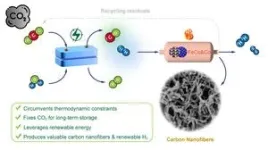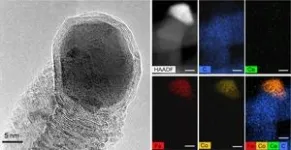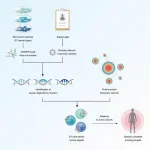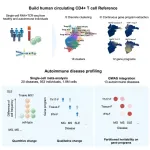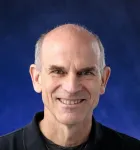(Press-News.org) UPTON, NY—Scientists at the U.S. Department of Energy’s (DOE) Brookhaven National Laboratory and Columbia University have developed a way to convert carbon dioxide (CO2), a potent greenhouse gas, into carbon nanofibers, materials with a wide range of unique properties and many potential long-term uses. Their strategy uses tandem electrochemical and thermochemical reactions run at relatively low temperatures and ambient pressure. As the scientists describe in the journal Nature Catalysis, this approach could successfully lock carbon away in a useful solid form to offset or even achieve negative carbon emissions.
“You can put the carbon nanofibers into cement to strengthen the cement,” said Jingguang Chen, a professor of chemical engineering at Columbia with a joint appointment at Brookhaven Lab who led the research. “That would lock the carbon away in concrete for at least 50 years, potentially longer. By then, the world should be shifted to primarily renewable energy sources that don’t emit carbon.”
As a bonus, the process also produces hydrogen gas (H2), a promising alternative fuel that, when used, creates zero emissions.
Capturing or converting carbon
The idea of capturing CO2 or converting it to other materials to combat climate change is not new. But simply storing CO2 gas can lead to leaks. And many CO2 conversions produce carbon-based chemicals or fuels that are used right away, which releases CO2 right back into the atmosphere.
“The novelty of this work is that we are trying to convert CO2 into something that is value-added but in a solid, useful form,” Chen said.
Such solid carbon materials—including carbon nanotubes and nanofibers with dimensions measuring billionths of a meter—have many appealing properties, including strength and thermal and electrical conductivity. But it’s no simple matter to extract carbon from carbon dioxide and get it to assemble into these fine-scale structures. One direct, heat-driven process requires temperatures in excess of 1,000 degrees Celsius.
“It’s very unrealistic for large-scale CO2 mitigation,” Chen said. “In contrast, we found a process that can occur at about 400 degrees Celsius, which is a much more practical, industrially achievable temperature.”
The tandem two-step
The trick was to break the reaction into stages and to use two different types of catalysts—materials that make it easier for molecules to come together and react.
“If you decouple the reaction into several sub-reaction steps you can consider using different kinds of energy input and catalysts to make each part of the reaction work,” said Brookhaven Lab and Columbia research scientist Zhenhua Xie, lead author on the paper.
The scientists started by realizing that carbon monoxide (CO) is a much better starting material than CO2 for making carbon nanofibers (CNF). Then they backtracked to find the most efficient way to generate CO from CO2.
Earlier work from their group steered them to use a commercially available electrocatalyst made of palladium supported on carbon. Electrocatalysts drive chemical reactions using an electric current. In the presence of flowing electrons and protons, the catalyst splits both CO2 and water (H2O) into CO and H2.
For the second step, the scientists turned to a heat-activated thermocatalyst made of an iron-cobalt alloy. It operates at temperatures around 400 degrees Celsius, significantly milder than a direct CO2-to-CNF conversion would require. They also discovered that adding a bit of extra metallic cobalt greatly enhances the formation of the carbon nanofibers.
“By coupling electrocatalysis and thermocatalysis, we are using this tandem process to achieve things that cannot be achieved by either process alone,” Chen said.
Catalyst characterization
To discover the details of how these catalysts operate, the scientists conducted a wide range of experiments. These included computational modeling studies, physical and chemical characterization studies at Brookhaven Lab’s National Synchrotron Light Source II (NSLS-II)—using the Quick X-ray Absorption and Scattering (QAS) and Inner-Shell Spectroscopy (ISS) beamlines—and microscopic imaging at the Electron Microscopy facility at the Lab’s Center for Functional Nanomaterials (CFN).
On the modeling front, the scientists used “density functional theory” (DFT) calculations to analyze the atomic arrangements and other characteristics of the catalysts when interacting with the active chemical environment.
“We are looking at the structures to determine what are the stable phases of the catalyst under reaction conditions,” explained study co-author Ping Liu of Brookhaven’s Chemistry Division who led these calculations. “We are looking at active sites and how these sites are bonding with the reaction intermediates. By determining the barriers, or transition states, from one step to another, we learn exactly how the catalyst is functioning during the reaction.”
X-ray diffraction and x-ray absorption experiments at NSLS-II tracked how the catalysts change physically and chemically during the reactions. For example, synchrotron x-rays revealed how the presence of electric current transforms metallic palladium in the catalyst into palladium hydride, a metal that is key to producing both H2 and CO in the first reaction stage.
For the second stage, “We wanted to know what’s the structure of the iron-cobalt system under reaction conditions and how to optimize the iron-cobalt catalyst,” Xie said. The x-ray experiments confirmed that both an alloy of iron and cobalt plus some extra metallic cobalt are present and needed to convert CO to carbon nanofibers.
“The two work together sequentially,” said Liu, whose DFT calculations helped explain the process.
“According to our study, the cobalt-iron sites in the alloy help to break the C-O bonds of carbon monoxide. That makes atomic carbon available to serve as the source for building carbon nanofibers. Then the extra cobalt is there to facilitate the formation of the C-C bonds that link up the carbon atoms,” she explained.
Recycle-ready, carbon-negative
“Transmission electron microscopy (TEM) analysis conducted at CFN revealed the morphologies, crystal structures, and elemental distributions within the carbon nanofibers both with and without catalysts,” said CFN scientist and study co-author Sooyeon Hwang.
The images show that, as the carbon nanofibers grow, the catalyst gets pushed up and away from the surface. That makes it easy to recycle the catalytic metal, Chen said.
“We use acid to leach the metal out without destroying the carbon nanofiber so we can concentrate the metals and recycle them to be used as a catalyst again,” he said.
This ease of catalyst recycling, commercial availability of the catalysts, and relatively mild reaction conditions for the second reaction all contribute to a favorable assessment of the energy and other costs associated with the process, the researchers said.
“For practical applications, both are really important—the CO2 footprint analysis and the recyclability of the catalyst,” said Chen. “Our technical results and these other analyses show that this tandem strategy opens a door for decarbonizing CO2 into valuable solid carbon products while producing renewable H2.”
If these processes are driven by renewable energy, the results would be truly carbon-negative, opening new opportunities for CO2 mitigation.
This research was supported by the DOE Office of Science (BES). The DFT calculations were performed using computational resources at CFN and at the National Energy Research Scientific Computing Center (NERSC) at DOE’s Lawrence Berkeley National Laboratory. NSLS-II, CFN, and NERSC are DOE Office of Science user facilities.
Brookhaven National Laboratory is supported by the Office of Science of the U.S. Department of Energy. The Office of Science is the single largest supporter of basic research in the physical sciences in the United States and is working to address some of the most pressing challenges of our time. For more information, visit science.energy.gov.
Follow @BrookhavenLab on social media. Find us on Instagram, LinkedIn, Twitter, and Facebook.
Related Links
Scientific paper: "CO2 fixation into carbon nanofibers using electrochemical-thermochemical tandem catalysis" END
Catalytic combo converts CO2 to solid carbon nanofibers
Tandem electrocatalytic-thermocatalytic conversion could help offset emissions of potent greenhouse gas by locking carbon away in a useful material
2024-01-11
ELSE PRESS RELEASES FROM THIS DATE:
Substance use disorders among adult cancer survivors
2024-01-11
About The Study: The findings of this study of 6,101 adult cancer survivors suggest that substance use disorder (SUD) prevalence is higher among survivors of certain types of cancer; this information could be used to identify cancer survivors who may benefit from integrated cancer and SUD care. Future efforts to understand and address the needs of adult cancer survivors with comorbid SUD should prioritize cancer populations in which SUD prevalence is high.
Authors: Devon K. Check, Ph.D., of the Duke University School of Medicine in Durham, North Carolina, is the corresponding author.
To access the ...
Head and neck cancer incidence before and during the pandemic
2024-01-11
About The Study: In this study of patients diagnosed with head and neck cancer from 2017 to 2020 in the U.S., the incidence of localized head and neck cancer declined during the first year of the pandemic. A subsequent increase in advanced-stage diagnoses may be observed in later years.
Authors: Nosayaba (Nosa) Osazuwa-Peters, B.D.S., Ph.D., M.P.H., C.H.E.S., of the Duke University School of Medicine in Durham, North Carolina, is the corresponding author.
To access the embargoed study: Visit ...
Wellcome Sanger Institute: Cancer drug discovery accelerated as hundreds of overlooked targets prioritised
2024-01-11
A new, systematic analysis of cancer cells identifies 370 candidate priority drug targets across 27 cancer types, including breast, lung and ovarian cancers.
By looking at multiple layers of functional and genomic information, researchers were able to create an unbiased, panoramic view of what enables cancer cells to grow and survive. They identify new opportunities for cancer therapies in a significant leap towards a new generation of smarter, more effective cancer treatments.
In the most comprehensive study of its kind, researchers ...
ChatGPT has read almost the whole internet. That hasn't solved its diversity issues
2024-01-11
AI language models are booming. The current frontrunner is ChatGPT, which can do everything from taking a bar exam, to creating an HR policy, to writing a movie script.
But it and other models still can’t reason like a human. In this Q&A, Dr. Vered Shwartz (she/her), assistant professor in the UBC department of computer science, and masters student Mehar Bhatia (she/her) explain why reasoning could be the next step in AI—and why it’s important to train these models using diverse ...
First direct imaging of small noble gas clusters at room temperature
2024-01-11
For the first time, scientists have succeeded in the stabilisation and direct imaging of small clusters of noble gas atoms at room temperature. This achievement opens up exciting possibilities for fundamental research in condensed matter physics and applications in quantum information technology. The key to this breakthrough, achieved by scientists at the University of Vienna in collaboration with colleagues at the University of Helsinki, was the confinement of noble gas atoms between two layers of graphene. This method overcomes the difficulty that noble gases do not form stable structures under experimental conditions ...
CD4+ T cell patterns linked to autoimmune disorders
2024-01-11
Osaka, Japan – Much like ripples on the water can betray powerful currents below the surface, small changes in our bodies can sometimes be an indicator of a serious condition. Now, researchers from Japan say that cells in the blood may provide telltale signs of important immune dysfunction.
In a study recently published in Cell Genomics, researchers from Osaka University have revealed that subtle changes in specific immune cell populations may signal the presence of an autoimmune disease.
In autoimmune conditions, which affect up to 5% of the population, the body’s immune cells attack the body ...
A tiny tattoo for a tabby
2024-01-11
Tokyo, Japan – If you’ve ever taken a car trip through a rural area, you might already know that livestock, including cows and sheep, can be individually tracked using decidedly old-fashioned methods, such as ear tags or even branding marks. By contrast, many tech-savvy pet owners have opted to have their dog or cat “chipped” by having a radio frequency identification (RFID) permanently implanted under the skin. However, all these identification solutions leave something to be desired, as ear tags can become damaged or lost, while RFID chips require an invasive procedure to insert and specialized equipment to read.
In a study recently published in Scientific ...
JMIR AI has passed the Scientific Quality Review by NLM for PMC
2024-01-11
JMIR Publications is pleased to announce that JMIR AI has passed the Scientific Quality Review by the US National Library of Medicine (NLM) for PubMed Central (PMC). This decision reflects the scientific and editorial quality of the journal. All articles published from 2022 onward will be found on PMC and PubMed after their technical evaluation.
Launched in 2022, JMIR AI is a new journal that focuses on the applications of artificial intelligence in health settings. This includes contemporary developments as well as historical ...
Researchers use spinning metasurfaces to craft compact thermal imaging system
2024-01-11
WASHINGTON — Researchers have developed a new technology that uses meta-optical devices to perform thermal imaging. The approach provides richer information about imaged objects, which could broaden the use of thermal imaging in fields such as autonomous navigation, security, thermography, medical imaging and remote sensing.
“Our method overcomes the challenges of traditional spectral thermal imagers, which are often bulky and delicate due to their reliance on large filter wheels or interferometers,” said research team leader Zubin Jacob from ...
John E. Carlstrom wins 2024 Dannie Heineman Prize for Astrophysics
2024-01-11
WASHINGTON, Jan. 11, 2024 – The Heineman Foundation, American Institute of Physics, and American Astronomical Society are pleased to announce John E. Carlstrom as the winner of the 2024 Dannie Heineman Prize for Astrophysics.
Carlstrom was selected “for pioneering work on microwave interferometry and his leading role in the development of the South Pole Telescope, leading to the observations of clusters of galaxies through the Sunyaev-Zeldovich effect, B-Mode polarization in the cosmic microwave background and strong evidence for a flat universe, all of which changed the field for generations to come.”
“AIP congratulates ...
LAST 30 PRESS RELEASES:
What determines the fate of a T cell?
Candida auris: genetic process revealed which could be treatment target for deadly fungal disease
Groundbreaking discovery turns household plastic recycling into anti-cancer medication
Blocking a key inflammatory pathway improves liver structure and vascular function in cirrhosis, study finds
Continuous spread: Raccoon roundworm detected in nine European countries
HKUST Engineering researchers developed a novel photodetector to enhance the performance of on-chip light monitoring
Strategic river sensors could have forewarned of Texas Camp flood disaster
Drone sampling of whale breath reveals first evidence of potentially deadly virus in Arctic
Roman soldiers defending Hadrian’s Wall infected by parasites, study finds
Pinochet’s prisoners were tormented with music but still found solace in it, a new book reveals
Fertility remains high in rural Tanzania despite access to family planning
AI-assisted device can improve autism care access
Kinetic careers
Uncovering how parasitic plants avoid attacking themselves to improve crop resistance
Nanoparticle vaccine strategy could protect against Ebola and other deadly filoviruses
Study finds brain care score can predict risk of stroke across racial groups
Key lung immune cells can intensify allergic reactions
Do hormones explain why women experience more gut pain?
New materials conduct ions in solids as easily as in liquids
Breakthrough of the Year: Renewable energy begins to eclipse fossil fuel-based sources
LLM use is reshaping scientific enterprise by increasing output, reducing quality and more
Introducing LightGen, a chip for ultra-fast, ultra-efficient generative AI
Astronomers see fireworks from violent collisions around nearby star
ACC/AHA issue new guideline on managing congenital heart disease in adults
Cosmic crash caught on camera
Is talented youth nurtured the wrong way? New study shows: top performers develop differently than assumed
Ants: An untapped resource in the development of antibiotics?
Archaeologists use AI to create prehistoric video game
Mitochondria migrate toward the cell membrane in response to high glucose levels
Tiny viral switch offers hope against drug-resistant bacteria
[Press-News.org] Catalytic combo converts CO2 to solid carbon nanofibersTandem electrocatalytic-thermocatalytic conversion could help offset emissions of potent greenhouse gas by locking carbon away in a useful material

